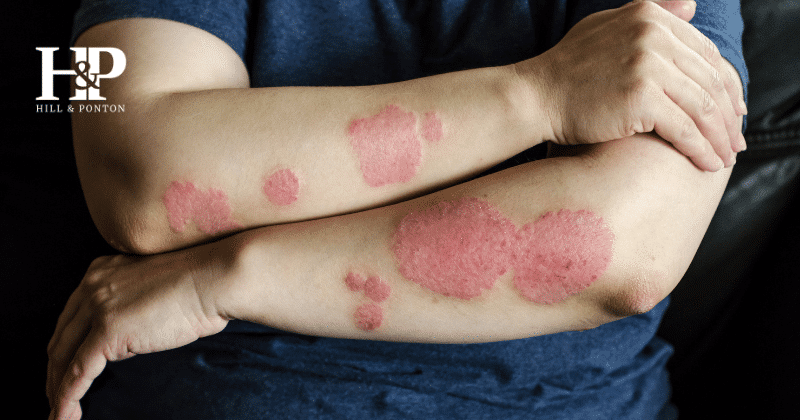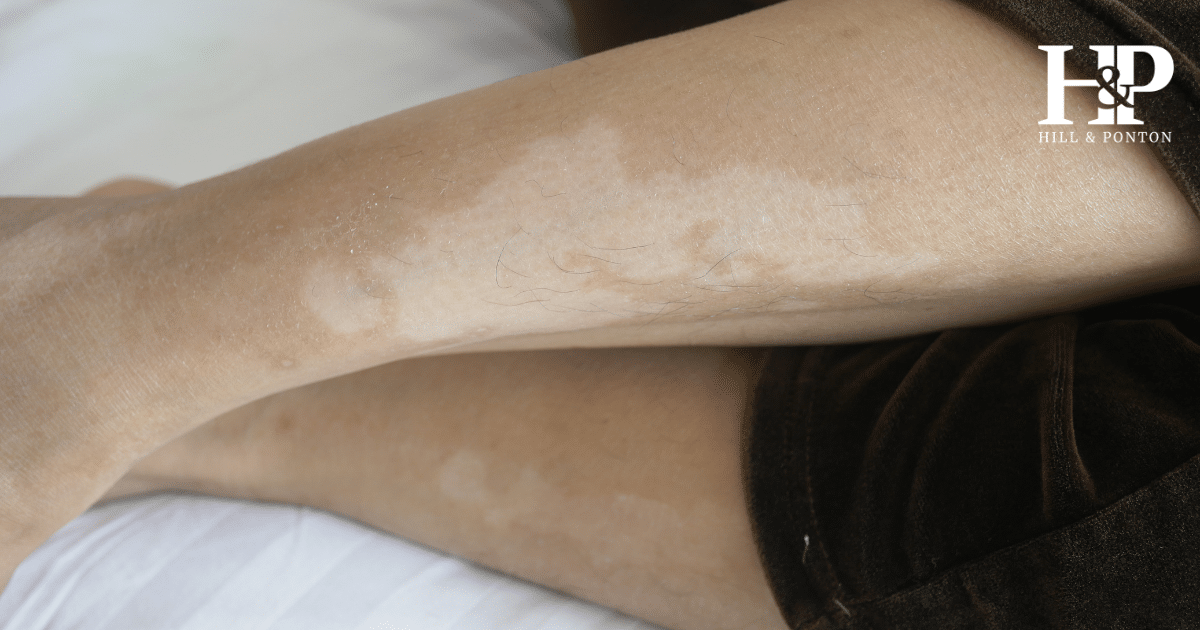Many Gulf War veterans, among others exposed to chemical and environmental hazards while serving, now face persistent skin conditions as a result.
These can linger long after their service has ended, complicating health and VA claims for disability compensation.
Presumptive Skin Conditions
Two specific skin conditions, chloracne and porphyria cutanea tarda, are presumed by the VA to be associated with exposure to Agent Orange during the Vietnam War. These conditions must manifest within a year of exposure to qualify for presumptive service connection, meaning they cannot develop years later.
The VA also recognizes 3 skin conditions that qualify as presumptive for Gulf War veterans include:
- Chronic Dermatitis: Characterized by inflamed, itchy and red skin, causing significant discomfort and sometimes requiring long-term treatment.
- Eczema: Involves patches of skin becoming inflamed, itchy, cracked and rough. In some cases, blisters may also appear, and flare ups are often difficult to manage.
- Psoriasis: An autoimmune disease that causes red, scaly patches on the skin. Gulf War veterans often report particularly severe outbreaks that impact their quality of life.
To be eligible for these presumptive conditions, veterans must have served in the Southwest Asia theater of operations during the Gulf War. This includes service in Iraq, Kuwait, Saudi Arabia and surrounding areas.
VA Disability Ratings for Chloracne
Chloracne is an unusual skin condition characterized by blackheads, cysts, and nodules, resembling severe acne. Unlike typical acne, which results from overactive oil-producing glands, chloracne occurs due to toxic chemical accumulation in the skin’s glands.
Symptoms include: blackheads, cysts and nodules, severe and potentially painful lesions, possible open sores and permanent scarring in severe cases.
Chloracne is often caused by: exposure to toxic substances like dioxin (Agent Orange), contact through ingestion, inhalation or skin absorption.
The VA Disability Ratings for Chloracne are as follows:
- 30 Percent: Deep acne with inflamed nodules and pus-filled cysts affecting 40% or more of the face and neck.
- 20 Percent: Deep acne with inflamed nodules and pus-filled cysts affecting intertriginous areas (e.g., armpits, anogenital region, skin folds of the breasts or between digits).
- 10 Percent: Deep acne with inflamed nodules and pus-filled cysts affecting less than 40% of the face and neck, OR deep acne affecting non-intertriginous areas of the body (other than the face and neck).
- 0 Percent: Superficial acne (e.g., comedones, papules, pustules) of any extent.
VA Rating for Porphyria Cutanea Tarda (PCT)
Porphyria cutanea tarda (PCT) leads to skin thinning and blistering, particularly in sun-exposed areas like the face, arms, and hands.
Symptoms include: blisters followed by crusting and scarring, hyperpigmentation, increased growth on sun-exposed areas, potential liver damage.
PCT is often caused by: Agent Orange exposure, sometimes hereditary but less common, or a combination of genetic, lifestyle and environmental factors.
The VA Disability Ratings for Porphyria Cutanea Tarda (PCT) are as follows:
- 60 Percent: Characteristic lesions cover more than 40% of the body or exposed areas, OR constant or near-constant systemic therapy (e.g., corticosteroids, phototherapy, retinoids, biologics, PUVA) over the past 12 months.
- 30 Percent: Characteristic lesions cover 20-40% of the body or exposed areas, OR systemic therapy (e.g., corticosteroids, phototherapy, retinoids, biologics, PUVA) for a total of 6 weeks or more intermittently over the past 12 months.
- 10 Percent: Characteristic lesions cover 5-20% of the body or exposed areas, OR intermittent systemic therapy for less than 6 weeks over the past 12 months.
Establishing Direct Service Connection for Skin Conditions
To secure VA disability compensation for skin conditions directly caused by military service, veterans must provide three things.
They include:
- A current diagnosis of a skin condition.
- Evidence of an in-service incident leading to the skin condition.
- A medical nexus linking the current skin condition to the in-service incident.
Did the VA Deny Your Disability Claim?
Let our team review your case today!
Get a Free Case EvaluationDisability Ratings for Common Skin Conditions
The VA uses a general rating formula to assess the severity of skin conditions:
- Conditions are rated based on how much of the body is affected and the severity of symptoms.
- Specific ratings depend on visible or symptomatic impairment and the impact on daily activities.
VA Disability Ratings for Psoriasis
Psoriasis is rated based on the frequency and severity of flare-ups and their response to treatment.
Ratings are as follows:
- 0% – No active disease but with some residual effects like scarring.
- 10% – Mild flare-ups a few times a year, responsive to treatment.
- 30% – Frequent moderate flare-ups requiring continuous treatment.
- 60% – Constant severe flare-ups, frequent hospitalization needed.
- 100% – Incapacitating episodes and a significant impact on daily activities.
VA Disability Ratings for Scars and Disfigurement
Scars and disfigurement from military service are rated based on location, size, and cosmetic impact.
Some of the considerations are:
- Scars on the head, face, or neck – Rated on disfigurement and skin loss.
- Other body areas – Typically rated based on the size of the scar.
- Ratings increase with the severity of symptoms and visibility of the scar.
VA Disability Benefits for Eczema
Eczema, or atopic dermatitis, often triggers due to environmental factors encountered during service.
Ratings vary from 0% for minor residual effects to 100% for severe cases affecting the veteran’s ability to work and perform daily tasks.
VA Disability Ratings for Acne Vulgaris
Acne vulgaris is a common skin condition that can be exacerbated by stressful environments, such as those experienced during military service.
Here’s the typical ratings:
- 0% – Mild acne without significant scarring or psychological effects.
- 10% – Moderate acne with frequent exacerbations requiring medical intervention.
- 30% – Severe acne with extensive scarring, painful cysts, and frequent infections requiring systemic treatment.
VA Disability Ratings for Dermatitis
Contact dermatitis and other forms of eczema can result from exposure to irritants or allergens in the military setting.
These are typical ratings:
- 10% – Intermittent dermatitis requiring topical medication.
- 30% – Persistent dermatitis with regular episodes affecting daily activities, requiring systemic medication.
- 60% – Chronic dermatitis with constant symptoms, affecting a significant body area and requiring systemic steroids or other immunosuppressive treatment.
VA Disability Ratings for Vitiligo
Vitiligo involves skin depigmentation, which can be psychologically and socially distressing.
Here’s ratings for Vitiligo:
- 0% – Limited areas of depigmentation not affecting physical capabilities.
- 10% – More extensive skin involvement requiring cosmetic cover-ups and UV treatments.
- 30% – Extensive areas of depigmentation affecting face, hands, and other visible areas, significantly impacting social or occupational activities.
VA Disability Ratings for Fungal Infections
Chronic or recurring fungal infections, often seen in veterans exposed to tropical climates or unsanitary conditions.
Here’s the ratings:
- 10% – Localized infections requiring intermittent treatment.
- 30% – Chronic widespread infections requiring continuous antifungal treatment.
- 60% – Infections with systemic involvement, frequent recurrences, and requiring long-term systemic therapy.
VA Disability Ratings for Urticaria (Hives)
Urticaria, or hives, can be chronic and debilitating, particularly when triggered by stress.
The ratings for hives are:
- 10% – Episodes of hives that are easily controlled and infrequent.
- 30% – Chronic urticaria that affects daily activities and requires regular antihistamine or corticosteroid treatment.
- 60% – Continuous, debilitating hives requiring immunosuppressive drugs or other systemic treatments.
VA Disability Ratings for Solar Keratosis
Often affecting veterans who served in high-sun-exposure environments.
Here’s the ratings for Solar Keratosis:
- 0% – Minimal impact, with lesions not requiring frequent treatment.
- 10% – Numerous lesions requiring regular cryotherapy or topical chemotherapy.
- 30% – Extensive lesions with frequent recurrences, requiring regular dermatological intervention.
VA Ratings for Skin Cancers
Skin Cancers are evaluated based on severity and required treatments.
For benign tumors requiring minimal intervention, the rating is typically 0%.
Malignant forms needing ongoing treatments such as surgery or chemotherapy may receive ratings up to 100% during active management.
Post-treatment ratings consider residual effects like scars, with potential adjustments based on the area and visibility of any disfigurement.
VA Ratings for Melanoma
Melanoma is rated by the VA for its aggressiveness and treatment complexity.
Active treatment phases involving surgery, chemotherapy, or immunotherapy may qualify for a temporary 100% rating.
Subsequent evaluations adjust the rating based on treatment residuals such as tissue loss or disfigurement, and the likelihood of recurrence.
VA Ratings for Carcinomas
Carcinomas, including basal and squamous cell types, are common but vary in aggression.
These cancers are rated based on the frequency and type of treatment required.
Continuous or repetitive treatment can lead to higher ratings, while significant disfigurement or functional loss due to surgery or other treatments may also increase the disability rating.
During active phases of aggressive treatments, a temporary 100% rating may be applicable.
Eligibility for VA Disability Benefits
Eligibility requires:
- A service-connected disability.
- Discharge under conditions other than dishonorable.
Veterans should seek a timely diagnosis and document all relevant medical treatment to support their claims effectively.
Join Thousands of Veterans!
Get the weekly newsletter that has helped veterans all over the country in the fight for their rightful benefits
join for free

